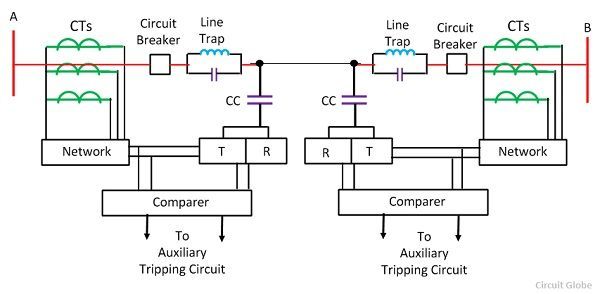Carrier current protection scheme is mainly used for the protection of the long transmission line. In the carrier, current protection schemes, the phase angle of the current at the two phases of the line are compared instead of the actual current. And then the phase angle of the line decides whether the fault is internal and external. The main elements of the carrier channel are a transmitter, receiver, coupling equipment, and line trap.
The carrier current receiver receives the carrier current from the transmitter at the distant end of the line. The receiver converts the received carrier current into a DC voltage that can be used in a relay or other circuit that performs any desired function. The voltage is zero when the carrier current, is not being received.
Line trap is inserted between the bus-bar and connection of coupling capacitor to the line. It is a parallel LC network tuned to resonance at the high frequency. The traps restrict the carrier current to the unprotected section so as to avoid interference from the with or the other adjacent carrier current channels. It also avoids the loss of the carrier current signal to the adjoining power circuit.
 The coupling capacitor connects the high-frequency equipment to one of the line conductors and simultaneously separate the power equipment from the high power line voltage. The normal current will be able to flow only through the line conductor, while the high current carrier current will circulate over the line conductor fitted with the high-frequency traps, through the trap capacitor and the ground.
The coupling capacitor connects the high-frequency equipment to one of the line conductors and simultaneously separate the power equipment from the high power line voltage. The normal current will be able to flow only through the line conductor, while the high current carrier current will circulate over the line conductor fitted with the high-frequency traps, through the trap capacitor and the ground.
Methods of Carrier Current Protection
The different methods of current carrier protection and the basic form of the carrier current protection are
- Directional Comparison protection
- Phase Comparison Protection
These types are explained below in details
1. Directional Comparison Protection
In this protection schemes, the protection can be done by the comparison of a fault of the power flow direction at the two ends of the line. The operation takes place only when the power at both the end of the line is on the bus to a line direction. After the direction comparison, the carrier pilot relay informs the equipment how a directional relay behaves at the other end to a short circuit.
The relay at both the end removes the fault from the bus. If the fault is in protection section the power flows in the protective direction and for the external fault power will flow in the opposite direction. During the fault, a simple signal through carrier pilot is transmitted from one end to the other. The pilot protection relaying schemes used for the protection of transmission are mainly classified into two types. They are
- Carrier Blocking Protection Scheme – The carrier blocking protection scheme restricts the operation of the relay. It blocks the fault before entering into the protected section of the system. It is one of the most reliable protecting schemes because it protects the system equipment from damage.
- Carrier Permitting Blocking Scheme – The carrier, protective schemes allows the fault current to enter into the protected section of the system.
2. Phase Comparison Carrier Protection
This system compares the phase relation between the current enter into the pilot zone and the current leaving the protected zone. The current magnitudes are not compared. It provided only main or primary protection and backup protection must be provided also. The circuit diagram of the phase comparison carrier protection scheme is shown in the figure below.
 The transmission line CTs feeds a network that transforms the CTs output current into a single phase sinusoidal output voltage. This voltage is applied to the carrier current transmitter and the comparer. The output of the carrier current receiver is also applied to the comparer. The comparer regulates the working of an auxiliary relay for tripping the transmission line circuit breaker.
The transmission line CTs feeds a network that transforms the CTs output current into a single phase sinusoidal output voltage. This voltage is applied to the carrier current transmitter and the comparer. The output of the carrier current receiver is also applied to the comparer. The comparer regulates the working of an auxiliary relay for tripping the transmission line circuit breaker.
Advantage of Carrier Current Protection
The following are the advantage of the carrier current protection schemes. These advantages are
- It has a fast and simultaneous operation of circuit breakers at both the ends.
- It has a fast, clearing process and prevents shock to the system.
- No separate wires are required for signalling because the power line themselves carry the power as well as communication signalling.
- It’s simultaneously tripping of circuit breakers at both the end of the line in one to three cycles.
- This system is best suited for fast relaying also with modern fast circuit breakers.
The main operation of power line carrier has been for the purpose of supervisory control, telephone communication, telemeter and relaying.

nice explanation
well and very nice explanation
Detailed explanation.
brilliant
I’m mesmerized !! Mind-blowing explanation. You deserve a Nobel prize.
These are some great information on the topic of current protection of transmission lines that you have discussed here. I really loved it and thank you very much for sharing this with us. You have a great visualization and you have really presented this content in a really good manner.